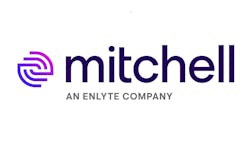Mitchell Q1 EV Collision Report: EV Repair Claims Rise as Industry Braces for Tariffs

Claims frequency for repairable, collision-damaged battery electric vehicles rose to 3.12% in the U.S. and 4.48% in Canada, according to Mitchell's Q1 2025 Plugged-In: EV Collisions Insights Report. That is an increase of approximately 31% in the U.S. and Canada over Q1 2024 and 2% and 4%, respectively, over the previous quarter.
BEV sales remain strong and account for more than 9% of new vehicle sales in the U.S. and 10% of new vehicle sales in Canada in March 2025. Tariffs threaten consumer adoption of electrified alternatives and the anticipated impact to manufacturing costs and, ultimately, the MSRP of new BEVs as well as the supply of used BEVs.
As of April 3, whole vehicles imported from outside of North America are subject to a 25% tariff. BEV automakers heavily dependent on European and Asian manufacturing centers — such as Hyundai, Kia, Mercedes Benz, and Nissan — will likely raise automobile prices to cover their cost increases. Automakers that primarily rely on Mexico for manufacturing may avoid additional tariff expenses, although they might make sticker price adjustments, since vehicles and components that are compliant with the U.S.-Mexico-Canada Agreement can still cross borders without incurring new import taxes. That includes high-production BEVs such as the Ford Mustang Mach-E, Volkswagen ID.4, and all Tesla models, which have between 15-78% Mexican-manufactured content and less tariff exposure.
In addition to the whole vehicle tariffs, the U.S. has also implemented import taxes on raw materials — specifically steel and aluminum — and auto parts. However, an amendment to the original White House proclamation introduced in late April eliminates the compounding of raw material and auto part tariffs as part of whole vehicle assembly applications. It also allows all manufacturers that assemble vehicles in the U.S. to temporarily offset a portion of the tariff cost on parts used in the production of new vehicles.
While sheet metal and other cosmetic and structural vehicle parts appear to be immune from the tariffs, other segments of the vehicle, such as electrical components, are not. These components include headlamps and tail lamps, which are common to all vehicles.
BEVs and plug-in hybrid electric vehicles are much more reliant on parts considered electrical components than automobiles with an internal combustion engine. For example, their high-voltage battery and electric motor — which are obviously not present in ICE automobiles — are two of the most prominent parts that also fall under the electrical component category.
As a result, a steep rise in the price of BEVs and PHEVs is expected for those that use imported batteries and motors from outside of North America. While average severity for repairable vehicles decreased in Q1, BEVs continue to have the highest claims severity when compared to other automobile types.
In the U.S., average severity was $5,927 for BEVs (-$678/-10% compared to Q4 2024), $5,526 for PHEVs (-$401/-7%), $4,644 for mild hybrid electric vehicles (MHEVs) (-$263/-5%) and $4,857 for ICE-powered options (-$406/-8%). The trend was similar in Canada, with average claims severity in Q1 of $7,026 CAD for BEVs (-$515 CAD/-7%), $6,253 CAD for PHEVs (-$287 CAD/-4%), $5,972 CAD for MHEVs (-$369 CAD/-6%) and $5,345 CAD for ICE automobiles (-$479 CAD/-8%).
For more information or to access past issues of the collision insight report, visit the Mitchell website here.
About the Author
FenderBender Staff Reporters
The FenderBender staff reporters have nearly four decades of combined journalism and collision repair experience.


